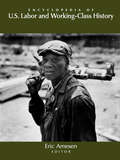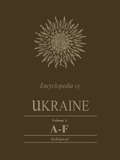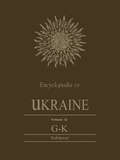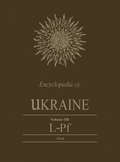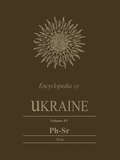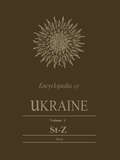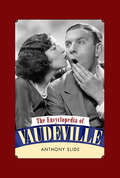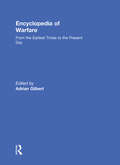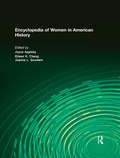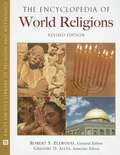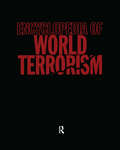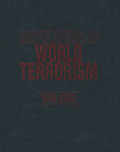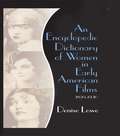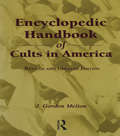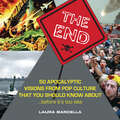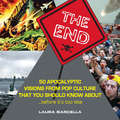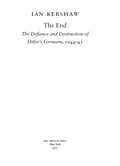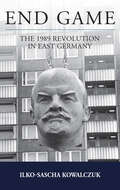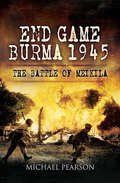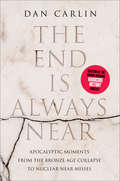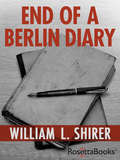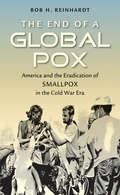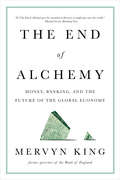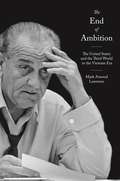- Table View
- List View
Encyclopedia of U.S. Labor and Working-Class History
by Eric ArnesenA RUSA 2007 Outstanding Reference Title The Encyclopedia of US Labor and Working-Class History provides sweeping coverage of US labor history. Containing over 650 entries, the Encyclopedia encompasses labor history from the colonial era to the present. Articles focus on states, regions, periods, economic sectors and occupations, race-relations, ethnicity, and religion, concepts and developments in labor economics, environmentalism, globalization, legal history, trade unions, strikes, organizations, individuals, management relations, and government agencies and commissions. Articles cover such issues as immigration and migratory labor, women and labor, labor in every war effort, slavery and the slave-trade, union-resistance by corporations such as Wal-Mart, and the history of cronyism and corruption, and the mafia within elements of labor history. Labor history is also considered in its representation in film, music, literature, and education. Important articles cover the perception of working-class culture, such as the surge in sympathy for the working class following September 11, 2001. Written as an objective social history, the Encyclopedia encapsulates the rise and decline, and continuous change of US labor history into the twenty-first century.
Encyclopedia of Ukraine: A-F plus Map and Gazetteer
by Volodymyr KubijovycOver thirty years in the making, the most comprehensive work in English on Ukraine is now complete: its history, people, geography, economy, and cultural heritage, both in Ukraine and in the diaspora.
Encyclopedia of Ukraine: G-K
by Volodymyr KubijovycThe appearance of Volume II of the Encyclopedia of Ukraine makes the second stage of a major publishing project. Based on twenty-five years' research by more than 100 scholars from around the world, the encyclopedia provides the most essential information about Ukraine and its people, history, geography, economy, and cultural heritage. Volume II contains entries beginning with the letters G to K, among them numerous biographies of historical figures and people currently living in and outside of Soviet Ukraine. Included are some 600 illustrations, maps, and statistical tables. The five volumes of the Encyclopedia of Ukraine will constitute a comprehensive guide to the life and culture of Ukrainians and reflect the manifold relations of Ukrainians with their neighbours and with their non-Ukrainian environments in the various countries to which they immigrated.
Encyclopedia of Ukraine: L-Pf
by Danylo Husar StrukOver thirty years in the making, the most comprehensive work in English on Ukraine is now complete: its history, people, geography, economy, and cultural heritage, both in Ukraine and in the diaspora.
Encyclopedia of Ukraine: Ph-Sr
by Danylo Husar StrukOver thirty years in the making, the most comprehensive work in English on Ukraine is now complete: its history, people, geography, economy, and cultural heritage, both in Ukraine and in the diaspora.
Encyclopedia of Ukraine: St-Z
by Danylo Husar StrukOver thirty years in the making, the most comprehensive work in English on Ukraine is now complete: its history, people, geography, economy, and cultural heritage, both in Ukraine and in the diaspora.
The Encyclopedia of Vaudeville
by Anthony SlideThe Encyclopedia of Vaudeville provides a unique record of what was once America's preeminent form of popular entertainment from the late 1800s through the early 1930s. It includes entries not only on the entertainers themselves, but also on those who worked behind the scenes, the theatres, genres, and historical terms. Entries on individual vaudevillians include biographical information, samplings of routines and, often, commentary by the performers. Many former vaudevillians were interviewed for the book, including Milton Berle, Block and Sully, Kitty Doner, Fifi D'Orsay, Nick Lucas, Ken Murray, Fayard Nicholas, Olga Petrova, Rose Marie, Arthur Tracy, and Rudy Vallee. Where appropriate, entries also include bibliographies. The volume concludes with a guide to vaudeville resources and a general bibliography. Aside from its reference value, with its more than five hundred entries, The Encyclopedia of Vaudeville discusses the careers of the famous and the forgotten. Many of the vaudevillians here, including Jack Benny, George Burns and Gracie Allen, Jimmy Durante, W. C. Fields, Bert Lahr, and Mae West, are familiar names today, thanks to their continuing careers on screen. At the same time, and given equal coverage, are forgotten acts: legendary female impersonators Bert Savoy and Jay Brennan, the vulgar Eva Tanguay with her billing as “The I Don't Care Girl,” male impersonator Kitty Doner, and a host of “freak” acts.
Encyclopedia of Warfare: From the Earliest Times to the Present Day
by Adrian GilbertThe Encyclopedia of Warfare is a chronological account of the development of warfare since the beginnings of recorded history. The book is organized in 10 chapters, each of which looks at a particular era in warfare from the ancient world to the present. Each chapter includes color maps of key campaigns, as well as commentary on battles, personalities, troops, and equipment. Sidebars throughout the main narrative focus on noteworthy aspects of the history of conflict. Through its chronological organization and ample use of maps, the Encyclopedia also clearly conveys the link between war and world geographical history. A thorough yet concise exploration of combat throughout human history, this fascinating and informative reference work is an outstanding addition to any library collection.
Encyclopedia of Women in American History
by Joyce Appleby Eileen Chang Neva GoodwinThis illustrated encyclopedia examines the unique influence and contributions of women in every era of American history, from the colonial period to the present. It not only covers the issues that have had an impact on women, but also traces the influence of women's achievements on society as a whole. Divided into three chronologically arranged volumes, the set includes historical surveys and thematic essays on central issues and political changes affecting women's lives during each period. These are followed by A-Z entries on significant events and social movements, laws, court cases and more, as well as profiles of notable American women from all walks of life and all fields of endeavor. Primary sources and original documents are included throughout.
The Encyclopedia of World Religions (Revised edition)
by Robert S. Ellwood Gregory D. AllesThe Encyclopedia of World Religions, Revised Edition, provides young adults with reliable, unbiased, and easy-to-use information on the world's religions, from ancient times to the present day. In about 600 entries--with 115 new to this edition--this revised edition covers all the major and minor religions of the world, including the religions of the ancient world; the major religions practiced around the world today; religions of contemporary indigenous peoples; definitions of religious symbols and ideas; key leaders and thinkers; and terms and definitions. The new entries and photographs broaden the encyclopedia's representation of current world events and the impact of those events on the world's religions. The book also covers religious fundamentalism--especially within Islam, Christianity, and Hinduism--and documents the burgeoning new religious movements in Latin America, Africa, East Asia, and the United States. All major entries now come with suggestions for further reading. New entries include: *Al-Qaeda *Apocrypha *Biblical prophets *Christianity fundamentalism *Christianity in Latin America, Asia, and Africa *Fundamentalism (general) *Hamas *Hebrew scriptures *Hindu fundamentalism *Independent Christianity *Islamic fundamentalism *Modern paganism *New Age movement *New religious movements in Africa *New religious movements in Brazil *New Testament *Politics and religion *UFO religions (e.g., Heaven's Gate).
Encyclopedia of World Terrorism
by Martha Crenshaw John PimlottThis three-volume reference on terrorism in the 20th century places this growing phenomenon in the context of modern history. It provides students with both detailed information and the historical perspective tie terrorism to the high school and college curriculum. "Volume 1" defines terrorism, explores the historical perspective from the dawn of Western Civilisation through World War II, and discusses specific activities of modern terrorist groups. "Volume 2" focuses on the developing world, with emphasis on the Middle East (including the 1996 peace process). "Volume 3" explores terrorism and responses to terrorism in the developed world. This volume covers the United States, Europe, Israel, Britain, Central and South America and concludes with a chronology of major terrorist events since 1945, an A-Z listing of terrorist groups and leaders, and a select bibliography.
Encyclopedia of World Terrorism: 1996-2002
by Frank G. Shanty Ray Picquet John LallaThis work examines terrorist activity worldwide from the mid-1990s to the 21st century. It covers the attack on the World Trade Center, the "War on Terrorism", and the escalating violence in Israel and Palestine, offering historical context by terrorism and counter-terrorism experts. It investigates key issues and events related to global and domestic terrorism, as well as future trends in terrorism and counter-terrorism. The work includes entries on terrorist individuals, organizations, and activities around the globe, and also features a complete volume of primary source documents relating to terrorism from ancient times to the 21st century.
An Encyclopedic Dictionary of Women in Early American Films: 1895-1930
by Denise LoweExamine women&’s contributions to film-in front of the camera and behind it! An Encyclopedic Dictionary of Women in Early American Films: 1895-1930 is an A-to-Z reference guide (illustrated with over 150 hard-to-find photographs!) that dispels the myth that men dominated the film industry during its formative years. Denise Lowe, author of Women and American Television: An Encyclopedia, presents a rich collection that profiles many of the women who were crucial to the development of cinema as an industry-and as an art form. Whether working behind the scenes as producers or publicists, behind the cameras as writers, directors, or editors, or in front of the lens as flappers, vamps, or serial queens, hundreds of women made profound and lasting contributions to the evolution of the motion picture production. An Encyclopedic Dictionary of Women in Early American Films: 1895-1930 gives you immediate access to the histories of many of the women who pioneered the early days of cinema-on screen and off. The book chronicles the well-known figures of the era, such as Alice Guy, Mary Pickford, and Francis Marion but gives equal billing to those who worked in anonymity as the industry moved from the silent era into the age of sound. Their individual stories of professional success and failure, artistic struggle and strife, and personal triumph and tragedy fill in the plot points missing from the complete saga of Hollywood&’s beginnings. Pioneers of the motion picture business found in An Encyclopedic Dictionary of Women in Early American Films include: Dorothy Arnzer, the first woman to join the Directors Guild of America and the only female director to make a successful transition from silent films to sound Jane Murfin, playwright and screenwriter who became supervisor of motion pictures at RKO Studios Gene Gauntier, the actress and scenarist whose adaptation of Ben Hur for the Kalem Film Company led to a landmark copyright infringement case Theda Bara, whose on-screen popularity virtually built Fox Studios before typecasting and overexposure destroyed her career Madame Sul-Te-Wan, née Nellie Conley, the first African-American actor or actress to sign a film contract and be a featured performer Dorothy Davenport, who parlayed the publicity surrounding her actor-husband&’s drug-related death into a career as a producer of social reform melodramas Lois Weber, a street-corner evangelist who became one of the best-known and highest-paid directors in Hollywood Lina Basquette, the "Screen Tragedy Girl" who married and divorced studio mogul Sam Warner, led The Hollywood Aristocrats Orchestra, claimed to have been a spy for the American Office of Strategic Services during World War II, and became a renowned dog expert in her later years and many more! An Encyclopedic Dictionary of Women in Early American Films: 1895-1930 also includes comprehensive appendices of the WAMPAS Baby Stars, the silent stars remembered in the Graumann Chinese Theater Forecourt of the Stars and those immortalized on the Hollywood Walk of Stars. The book is invaluable as a resource for researchers, librarians, academics working in film, popular culture, and women&’s history, and to anyone interested either professionally or casually in the early days of Hollywood and the motion picture industry.
Encyclopedic Handbook of Cults in America (Religious Information Systems #7)
by J. Gordon MeltonFirst Published in 1993. Routledge is an imprint of Taylor & Francis, an informa company.
The End: 50 Apocalyptic Visions From Pop Culture That You Should Know About...Before It's Too Late
by Laura BarcellaPeople have been making predictions about how and when the world is going to end for ages. The End is a fun pop culture read about the top 50 movies, books, songs, and artworks—from the movie Shaun of the Dead to the song It's the End of the World as We Know It—about the apocalypse. Each item includes: - A synopsis of the apocalyptic work - Information about the apocalyptic theory behind it (from alien invasion to meteors, nuclear war, and natural disasters) - An explanation about why this work is important in pop culture Love doomsday talk and the art made about it? Check out this fun and entertaining read!
The End
by Laura BarcellaYou've probably heard rumors that the end of the world is going to happen in the year 2012. But people have been making predictions about how and when the world is going to end for ages. The End is a fun, comprehensive, pop culture read about the 50 top movies, books, songs, comics, artworks, and plays--from the movie Shaun of the Dead to the pop song "It's the End of the World as We Know It"--that have been created about the apocalypse. Each item includes: a synopsis of the apocalyptic work information about the apocalyptic theory behind it (from alien invasion to meteors, nuclear war, and natural disasters) an explanation about why this work is important in pop culture Love doomsday talk and the art that is made about it? Check out this fun and entertaining read!
The End
by Ian KershawFrom the preeminent Hitler biographer, a fascinating and original exploration of how the Third Reich was willing and able to fight to the bitter end of World War II Countless books have been written about why Nazi Germany lost the Second World War, yet remarkably little attention has been paid to the equally vital questions of how and why the Third Reich did not surrender until Germany had been left in ruins and almost completely occupied. Drawing on prodigious new research, Ian Kershaw, an award-winning historian and the author of Fateful Choices, explores these fascinating questions in a gripping and focused narrative that begins with the failed bomb plot in July 1944 and ends with the death of Adolf Hitler and the German capitulation in 1945. The End paints a harrowing yet enthralling portrait of the Third Reich in its last desperate gasps.
End Game: The 1989 Revolution in East Germany (Studies in German History #26)
by Ilko-Sascha KowalczukThe fall of the Berlin Wall, and the chain of events leading up to it, arguably constitute one of the most thoroughly documented episodes in recent history. Nonetheless, most accounts have focused predominantly on high-level politics and diplomacy along with the most dramatic and photogenic public displays. End Game, a rich, sweeping account of the autumn of 1989 as it was experienced “on the ground” in the German Democratic Republic, powerfully depicting the desolation and dysfunction that shaped everyday life for so many East Germans in the face of economic disruption and political impotence. Citizens’ frustration mounted until it bubbled over in the form of massive demonstrations and other forms of protest. Following the story up to the first free elections in March 1990, the volume combines abundant detail with sharp analysis and helps us to see this familiar historical moment through new eyes.
End Game Burma, 1945: Slim’s Masterstroke at Meikila
by Michael PearsonWhen the Burma campaign is discussed, the turning point battles of Imphal and Kohima are most often thought of. However General Bill Slims bold but risky plan to outflank the Japanese on the Irrawaddy at Mandalay deserves far more credit.With the Japanese withdrawing, Slims 14 Army (with two Corps XXXIII and IV) risked a punishing crossing of the mighty Irrawaddy at Mandalay opposed by the main Japanese army. To avoid this is was decided to split 14 Army and send IV Corps on an arduous 300 mile march to seize the town of Meiktila, 85 miles south, a vital rail and road hub and the main Japanese administrative base.Complete secrecy was essential as if the Japanese realized they faced only one Corps rather than two, they might have counter attacked successfully. In this detailed analysis of this crucial maneuver the author describes the plan, the risks, the actions, the seemingly insuperable logistic problems, and the efforts to retain US air support (for which Mountbatten was largely responsible).
The End Is Always Near: Apocalyptic Moments, from the Bronze Age Collapse to Nuclear Near Misses
by Dan CarlinThe creator of the wildly popular award-winning podcast Hardcore History looks at some of the apocalyptic moments from the past as a way to frame the challenges of the future.Do tough times create tougher people? Can humanity handle the power of its weapons without destroying itself? Will human technology or capabilities ever peak or regress? No one knows the answers to such questions, but no one asks them in a more interesting way than Dan Carlin.In The End is Always Near, Dan Carlin looks at questions and historical events that force us to consider what sounds like fantasy; that we might suffer the same fate that all previous eras did. Will our world ever become a ruin for future archaeologists to dig up and explore? The questions themselves are both philosophical and like something out of The Twilight Zone.Combining his trademark mix of storytelling, history and weirdness Dan Carlin connects the past and future in fascinating and colorful ways. At the same time the questions he asks us to consider involve the most important issue imaginable: human survival. From the collapse of the Bronze Age to the challenges of the nuclear era the issue has hung over humanity like a persistent Sword of Damocles.Inspired by his podcast, The End is Always Near challenges the way we look at the past and ourselves. In this absorbing compendium, Carlin embarks on a whole new set of stories and major cliffhangers that will keep readers enthralled. Idiosyncratic and erudite, offbeat yet profound, The End is Always Near examines issues that are rarely presented, and makes the past immediately relevant to our very turbulent present.
End of a Berlin Diary
by William L. Shirer"When I came home from Berlin at Christmas time in 1940, I found most of my fellow countrymen unaware of what Hitler was really up to and somewhat confused as to how he had accomplished his evil designs. Some Americans didn't much care. Since it had been my lot to witness Europe's agony at first hand, I collected some of my notes in a book for the edification of such citizens as cared to read it. This book of notes is, in a way, a sequel to Berlin Diary. It is the end of my own small contribution to the Berlin story. There was a great deal, of course, that a reporter had not been able to learn in the frenzied Nazi capital beyond the Elbe. The sinister plots, the fateful decisions, that had plunged the world into such awful horror and misery had been made in secret. And what had really gone on in Germany after I left? Had defeat and collapse solved the German problem -- at least for the rest of our lifetime ? After the war's end I went back to Berlin to try to find out. I prowled the obscene ruins of the once proud capital and talked with the remnants of the Herrenvolk. At Nuremberg, amidst the debris of the lovely medieval town, I saw the surviving leaders of the Nazi gangster world, who had wielded such monstrous power so arrogantly when last I beheld them, finally brought to justice. Most important of all, I had access to a good part of the fourteen hundred tons of secret German documents that the Allies had captured intact. You will find the essential portions of many of them in this book. I have been content to let the German authors tell in their own inimitable words the dark and almost unbelievable tale of their savagery and deceit. Had these secret archives of the German government been destroyed, as the Nazis intended them to be, much of the truth about our weird period in history would have been buried forever. Now it is here for those who care to learn it. I have also tried to include in this book the thread of another story -- the story of the beginning of the Peace. Reader, you and I have already forgotten the fleeting moment of glory and man's magnificent sense of dedication the day peace descended on this wretched earth. I know that erring mortals cannot remain on the heights for long. But these notes, scribbled down at the time, may help to remind you that many on our side achieved those heights after the war's bloody struggles had brought out their inhuman courage, their bravery, and their wonderful fortitude."
End of a Berlin Diary
by William L. Shirer&“A vivid and unforgettable word picture of the destruction of Nazi Germany&” (The New York Times). A radio broadcaster and journalist for Edward R. Murrow at CBS, William L. Shirer was new to the world of broadcast journalism when he began keeping a diary while on assignment in Europe during the 1930s. It was in 1940, when he was still virtually unknown, that Shirer wondered whether his eyewitness account of the collapse of the world around Nazi Germany could be of any interest or value as a book. Shirer&’s Berlin Diary, which is considered the first full record of what was happening in Germany during the rise of the Third Reich, appeared in 1941. The book was an instant success—and would not be the last of his expert observations on Europe. Shirer returned to the European front in 1944 to cover the end of the war. As the smoke cleared, Shirer—who watched the birth of a monster that threatened to engulf the world—now stood witness to the death of the Third Reich. End of a Berlin Diary chronicles this year-long study of Germany after Hitler. Through a combination of Shirer&’s lucid, honest reporting, along with passages on the Nuremberg trials, copies of captured Nazi documents, and an eyewitness account of Hitler&’s last days, Shirer provides insight into the unrest, the weariness, and the tentative steps world leaders took towards peace.
The End of a Global Pox: America and the Eradication of Smallpox in the Cold War Era (Flows, Migrations, and Exchanges)
by Bob H. ReinhardtBy the mid-twentieth century, smallpox had vanished from North America and Europe but continued to persist throughout Africa, Asia, and South America. In 1965, the United States joined an international effort to eradicate the disease, and after fifteen years of steady progress, the effort succeeded. Bob H. Reinhardt demonstrates that the fight against smallpox drew American liberals into new and complex relationships in the global Cold War, as he narrates the history of the only cooperative international effort to successfully eliminate a disease. Unlike other works that have chronicled the fight against smallpox by offering a "biography" of the disease or employing a triumphalist narrative of a public health victory, The End of a Global Pox examines the eradication program as a complex exercise of American power. Reinhardt draws on methods from environmental, medical, and political history to interpret the global eradication effort as an extension of U.S. technological, medical, and political power. This book demonstrates the far-reaching manifestations of American liberalism and Cold War ideology and sheds new light on the history of global public health and development.
The End of Alchemy: Money, Banking, and the Future of the Global Economy
by Mervyn King"Mervyn King may well have written the most important book to come out of the financial crisis. Agree or disagree, King's visionary ideas deserve the attention of everyone from economics students to heads of state." --Lawrence H. Summers Something is wrong with our banking system. We all sense that, but Mervyn King knows it firsthand; his ten years at the helm of the Bank of England, including at the height of the financial crisis, revealed profound truths about the mechanisms of our capitalist society. In The End of Alchemy he offers us an essential work about the history and future of money and banking, the keys to modern finance. The Industrial Revolution built the foundation of our modern capitalist age. Yet the flowering of technological innovations during that dynamic period relied on the widespread adoption of two much older ideas: the creation of paper money and the invention of banks that issued credit. We take these systems for granted today, yet at their core both ideas were revolutionary and almost magical. Common paper became as precious as gold, and risky long-term loans were transformed into safe short-term bank deposits. As King argues, this is financial alchemy--the creation of extraordinary financial powers that defy reality and common sense. Faith in these powers has led to huge benefits; the liquidity they create has fueled economic growth for two centuries now. However, they have also produced an unending string of economic disasters, from hyperinflations to banking collapses to the recent global recession and current stagnation. How do we reconcile the potent strengths of these ideas with their inherent weaknesses? King draws on his unique experience to present fresh interpretations of these economic forces and to point the way forward for the global economy. His bold solutions cut through current overstuffed and needlessly complex legislation to provide a clear path to durable prosperity and the end of overreliance on the alchemy of our financial ancestors.
The End of Ambition: The United States and the Third World in the Vietnam Era (America in the World #46)
by Mark Atwood LawrenceA groundbreaking new history of how the Vietnam War thwarted U.S. liberal ambitions in the developing world and at home in the 1960sAt the start of the 1960s, John F. Kennedy and other American liberals expressed boundless optimism about the ability of the United States to promote democracy and development in Asia, Africa, the Middle East, and Latin America. With U.S. power, resources, and expertise, almost anything seemed possible in the countries of the Cold War’s “Third World”—developing, postcolonial nations unaligned with the United States or Soviet Union. Yet by the end of the decade, this vision lay in ruins. What happened? In The End of Ambition, Mark Atwood Lawrence offers a groundbreaking new history of America’s most consequential decade. He reveals how the Vietnam War, combined with dizzying social and political changes in the United States, led to a collapse of American liberal ambition in the Third World—and how this transformation was connected to shrinking aspirations back home in America.By the middle and late 1960s, democracy had given way to dictatorship in many Third World countries, while poverty and inequality remained pervasive. As America’s costly war in Vietnam dragged on and as the Kennedy years gave way to the administrations of Lyndon B. Johnson and Richard M. Nixon, America became increasingly risk averse and embraced a new policy of promoting mere stability in the Third World. Paying special attention to the U.S. relationships with Brazil, India, Iran, Indonesia, and southern Africa, The End of Ambition tells the story of this momentous change and of how international and U.S. events intertwined.The result is an original new perspective on a war that continues to haunt U.S. foreign policy today.
